In 2017, psychologist Irina Soloviova published a book entitled Who Are We Really? The Subconscious Body Image (Moscow). This paper summarizes the theoretical portion of this work. In addition to the theory, the book contains practical exercises on how to correct one’s body image.
“Who am I?” This is one of the key questions in psychology. It is a fundamental, pivotal and existential question in the life of a human being. All other questions proceed from it: “What is my purpose?”, “Where am I going?” etc. Answering the question “Who am I” automatically answers those subsequent questions. But only the individual can answer this question. Seeking answers elsewhere is a pointless endeavour.
Other people can only say: “How I see you,” “How I perceive you,” and their estimations are usually based on their own projections and fantasies. Only the individual knows who he or she really is. But in order to do this, we need to take responsibility for ourselves, for our lives, and not shift this responsibility elsewhere, convincing ourselves that we are “victims of circumstance,” “chance coincidences”, etc.
Answer to the question “Who am I” means taking responsibility for ourselves and our lives, and this is a frightening prospect. But it is responsibility that is the main characteristic of psychological maturity, an indicator of a psychological “coming-of-age.”
The answer to the question “Who am I” can have different layers of complexity, basic levels of identification. The basic self-image is the self-concept. As a psychological construct, the self-concept starts to form at approximately eighteen months, when the child gradually starts to separate him/herself from the surrounding world, emerges from the so-called “oceanic merger” with the world and begins to develop self-awareness.
The self-concept consists of two parts: self-image and self-relationship.
Self-image is the representation of the self as a subject: “Who am I?” Self-relationship asks the question: “What am I?”
Self-image is the primary and basic characteristic, ontogenetically earlier. Self-relationship develops later, when the child begins to understand that they, and their actions, are being judged by significant people in their lives (primarily their parents). This usually happens at around eighteen months to two years. A one-year-old child experiences unconditional love, and everything they do is embraced wholeheartedly. At two years old, however, their actions are judged and scrutinized. This is a part of socialization – the formation of the child as a social subject, their initiation into society.
Self-relationship is the result of internalization (appropriation from the outside to the inside) of attitudes towards the child.
Self-image is a more objective characteristic, based on objective reality. It is easy to verify the adequacy of the self-image through its correlation with reality, as a significant part of the characteristics that make up the self-image are objective: gender, age, etc.
Self-relationship is an entirely subjective and evaluative characteristic. This is not, and cannot be a “unit of measurement” for determining the value and “merits” of the individual…
It follows from this that the self-image is a more constant (permanent) characteristic, while self-relationship is fluid.
Self-image consists of several sub-structures. Traditionally, these are:
- The physical self– our perception of our bodies;
- The psychological self – our perception of our psychological qualities, traits, psychological profile, etc.;
- The social self – the I as a social subject, my place and role in society;
- The spiritual self – our perception of our spiritual qualities.
While the last three constructs have been studied in great depth by psychologists, sociologists, philosophers and experts from other disciplines who are interested in the subject, the physical self has, strangely enough, received very little attention.
Moshé Feldenkrais (1904–1984), founder of the system of functional rehabilitation and body awareness worked with the physical self. Feldenkrais proposed studying body image, specifically the subconscious aspect of it (how we feel our bodies, rather than how we perceive them). After all, self-image is not as simple as it seems. We are aware of just a small part of it. This means that we all perceive our bodies in two ways: consciously and subconsciously.
Conscious perception is closer to reality. In a mentally healthy individual, it largely correlates with reality. One of the ways in which a pathology manifests itself is in impaired reality testing – that is, a deficient perception of reality. Thus, anorexia is a borderline state, as the conscious body image of someone suffering from the illness is far from their actual body image: even though they are quite obviously underweight, they perceive themselves as being fat.
The subconscious perception of one’s body can differ from reality even in mentally healthy individuals. On average distortion of their body image (a perception of their body that does not coincide with reality) amounts to 20-25%.
In order to change your life, you need to change your patterns of action. And to do this, you need to change your self-image. And the easiest place to start is by changing your body image. It is impossible for an individual to have a realistic idea about themselves as a whole (i.e. about their psychological characteristics) when they have a distorted body image.
Moshé Feldenkrais proposed the principle of diagnosing the subconscious body image, which involves asking the patient to close their eyes and indicate the dimensions of their body. This principle was used as the basis for the creation of the Feldenkrais Method in 2001–2002 (I. Soloviova, early studies at Russian State University for the Humanities). The method involves taking measurements of 15 physical parameters (head breadth, shoulder breadth, etc.). The data obtained is recorded on a piece of paper on a 10:1 scale. The result is a schematic representation of the human body, which reflects the individual’s unconscious body image.
The method allows for a quantitative and qualitative analysis to be performed:
- Quantitative analysis involves calculating the percentage of each of the distorted parameters (a problem zone is identified), as well the overall average distortion (the total distortion of the individual’s body image). Of course, in order to perform such an analysis, information on the individual’s body image and their real physical parameters is required: pelvimeters are primarily used for this purpose.
- Qualitative analysis involves studying the resulting visual subconscious body image.
We would like to focus on qualitative analysis here.
The individual’s body image reflects their character structure (this is sometimes referred to as their “psychological type”). The method used to diagnose the person’s subconscious body image can thus be used to diagnose the structure of their character.
You can find different systems of character structures in Body Psychotherapy: Vegetotherapy (Wilhelm Reich), Biosynthesis (David Boadella), Bioenergetic analysis (Alexander Lowen), Bodinamic (Lisbeth Marcher)... They have psychoanalysis base.
Our basic character structure and the main features of our subconscious body image are formed during our formative years, by the age of 7. These features can then change significantly during puberty (in adolescence, between the ages of 12 and 16), and they rarely undergo radical changes after the age of 18.
Thus, character structure gives us an idea of the person’s psychological profile, their core issues, individual life strategy, resources, defences, communication patterns and many more important characteristics. In turn, we can diagnose character structure by the individual’s subconscious body image.
We would like to propose the following typology of character structures that simplify the process of performing a qualitative analysis of subconscious body image. Remember that an individual’s subconscious body image can differ greatly from their real physical body.
These images are the subconscious body images, not the real physical bodies.
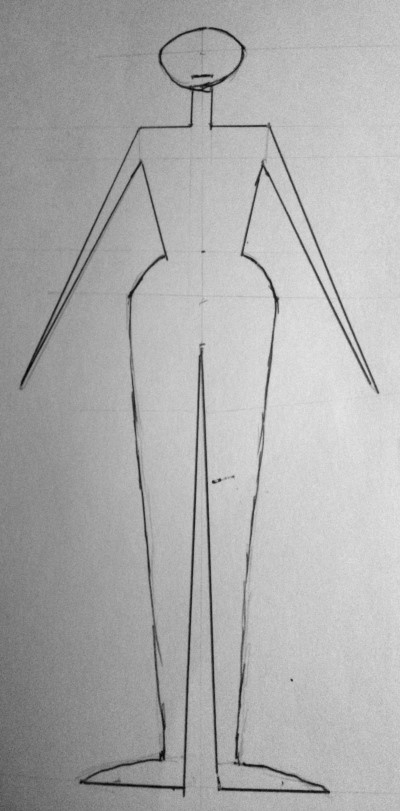
Illustration 1. A 42-year-old woman seeking help for psychological help (to deal with issues of co-dependence). We can see a fairly harmonious unconscious body image. Nevertheless, certain distortions are present, and the internal, subjective body image differs from the objective physical body image.
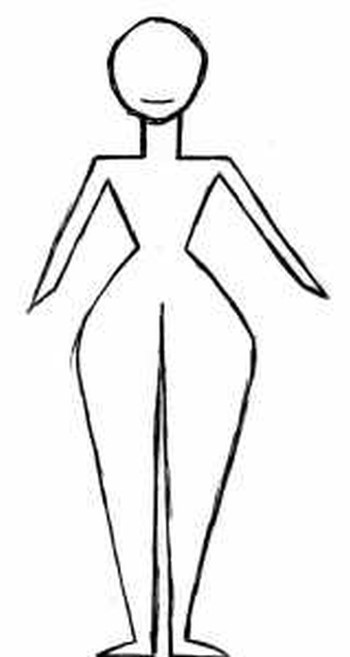
Illustration 2. A vivid example of the discrepancy between the person’s real body and that person’s perception of their body. The subconscious body image of a transsexual is a person with a disturbance of gender identity. Biologically, it is a 35-year-old male with a large physique. The psychological subconscious body image bears all the signs of femininity.
Nobody is completely one type. We are all a combination of two to three character structures (or more). We will provide examples of schematic body images which accurately reflect a given character structure.
Schizoid character structure.
The name “Schizoid character structure” is the most common. However, in the Bodynamic Analysis (Denmark), the name “mental structure of existence” may be used.
Age at which this character structure is formed. The prenatal period (in the womb), birth, the first six months of infancy.
Reason for the formation of such a body image. Rejection trauma that leads to an inability to cope with the basic right to exist.
Actual body. Thin, round-shouldered (head tucked into the shoulders), weak muscles, an asymmetrical body in many respects, unfocused eyes.
Subconscious Body image. Thin and long, reminiscent of a “stick”; the proportions of the neck, torso, arms and legs are elongated (like a sprout trying to break through a dark and unforgiving forest to feel the rays of the sun, where it will be better). A big head (its width sometimes exceeds its length, which signifies rationality and mentality). Small feet (indicating trust issues – the person finds it difficult to rely on themselves and on others). A small mouth (unsociability, inability to express oneself and interact with others). There is no indication of gender. However, this does not point to a breakdown of sexual identity (transsexualism), but rather an unformed, pre-genital character structure, and questions of sexuality are not yet relevant for this psychological age.
Psychological portrait. This type of person is always asking the Shakespearian question “To be, or not to be?” They feel superfluous in this world, unneeded and have a basic distrust in the word, which feels unsafe and rejecting. This type of person uses rationalization, disregard and dissociation as defence mechanisms. Their perception of the world is cognitive, and their emotions are suppressed. This kind of person is closed. They find it difficult to establish a rapport with others and feel lonely. The usual career path involves intellectual work – IT, science…
Psychological help. Mastering the basic right to exist, which entails showing the person what it feels like to have universal understanding and helping them feel important and needed in this world.
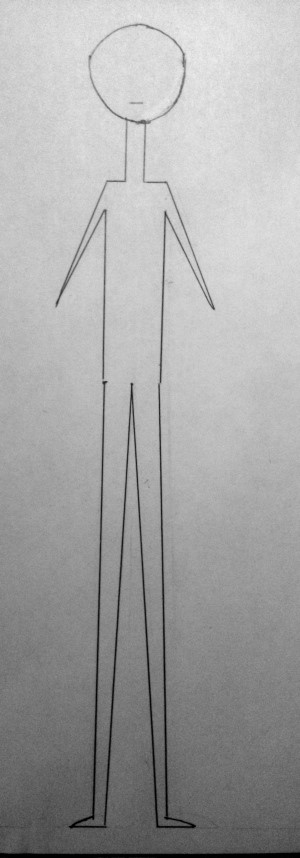
Illustration 3. Typical Subconscious Body image of Schizoid.
Oral character structure.
Age at which this character structure is formed: the first eighteen months of life (henceforth referred to as “after birth”).
Reason for the formation of such a body image. Deprivation of oral needs: the result of some kind of disrupted care in infancy. The reasons for this vary: ignoring the needs of the child; excessive care; lack of understanding of the child’s needs, etc. This is why oral types are so diverse: the emotional structure of existence, structure of needs (the Bodynamic Analysis of Lisbeth Marcher, Denmark), a paranoid and depressive type (the “Psychoanalytic Diagnosis” of Nancy McWilliams, United States), etc.
Actual body. There are many different kinds of oral injury (suffered in infancy), hence the variability of the oral type. Nevertheless, we will attempt to outline the general characteristics: underweight (unnaturally lean) or excessive weight (obvious obesity, evenly distributed throughout the body). Weak legs, almost X-shaped. Oral fixation: constant movements of the mouth, biting or sucking, touching the mouth area (with the hands or another object, for example a pen or a cigarette). Hands are tensed up in a “claw-like” shape, fingers appear to want to squeeze something (like a baby clinging to the hand of an adult). Eyes are focused, searching for contact.
Subconscious Body image. Short and broad, like a “balloon” (the oral need to be filled). A small head (impulsiveness, lack of self-control and awareness). Small feet (indicating a basic problem with trust – the inability to rely on oneself and the need to rely on others). A large mouth (suppressed oral needs striving to be satisfied).
Psychological portrait. This type of person strives to establish symbiosis: contact-fusion in which needs will be met in full. They do not tolerate frustration of their needs (they get angry, balk and insist on having things their way). This type of person cannot be alone. They are always looking for care, or to compensate by caring others. They often find themselves in emotionally dependent and destructive relationships (married to an alcoholic, etc.). This type of person chooses a profession that involves working with people (doctor, psychologist, teacher, tour guide, etc.).
Psychological help. Teaching the person how to satisfy their own needs.
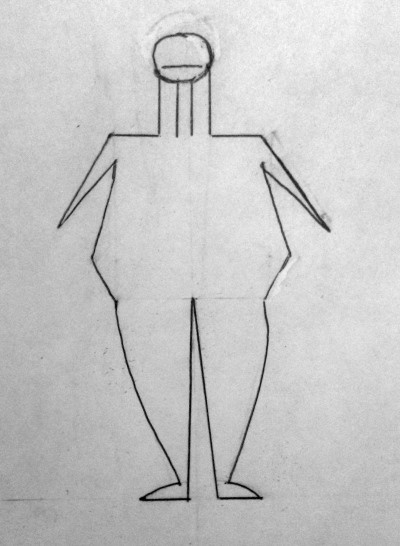
Illustration 4. Typical Subconscious Body image of the person with Oral character structure.
Masochistic character structure.
Age at which this character structure is formed: around 1-and-a-half to 2-and-a-half years.
Reason for the formation of such a body image. Refusal to be separated in order to maintain contact, accompanied by an infringement on the person’s dignity. At this stage of development, which is called the autonomy stage, the child starts to become separated from the parental space. Not all parents (particularly mothers) can accept this. Subconsciously, they hold the child back, punishing them for trying to show independence by rejecting them. Being small and completely dependent, the child subconsciously decides to sacrifice their independence in order to preserve the love and protection of their mother. However, the child experiences this as a defeat, as humiliation.
Actual body. Full hips and pelvis, even among males. But the shoulders are weak and stooped, and the chest appears sunken in under their weight. The neck is short and fat. The person walks in a laboured manner. Their body is rigid and moves sluggishly. The eyes look upwards, in a guilty manner.
Subconscious Body image. A broad body, particularly the lower half of the body. Long feet and wide hips. A thick torso without a discernible waist, although the chest is thin. A large head on top of a “bullish.” All of these signs symbolize one thing: “I can tolerate anything. I take responsibility for everything.” Small mouth (to stop the person saying what they think).
Psychological portrait. Wounded narcissism – a sense of one’s own badness, the need for approval and the dependence on the opinions of others. This type of person strives to have their egos “stroked” by others. They suffer from low self-esteem. They are devoted, conservative, fear change and are psychologically rigid. This type of person harbours a lot of repressed anger. They often feel guilty and ashamed. The usual career path for this character type involves jobs that require patience and attention to detail (for example, accountancy).
Psychological help. Forming a sense of the person’s “goodness,” helping them with separation, strengthening borders, developing anger management skills.
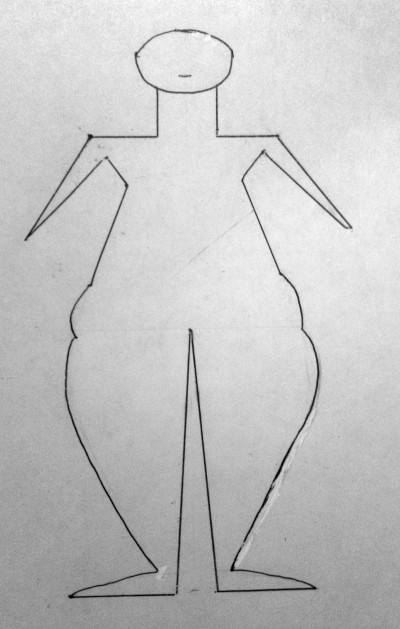
Illustration 5. Typical Subconscious Body image of the person with Masochistic character structure.
Psychopathic character structure.
Age at which this character structure is formed: approximately 2–3 years.
Reason for the formation of such a body image. Purposely avoiding contact in order to be separated from others. Accordingly, a fixation on power, upholding their independence and significance. During the autonomy stage, parents may place too great an emphasis on the independence and successes of their child, due, for example, to their own narcissism: “My child is the best!” Or they may indulge the child’s rage-filled hysterics (this tends to happen in situations where there the mother is weak, and the father is distant).
Actual body. A straight back, tense shoulders thrust backwards, a condescending and controlling look, a mask-like face, straight legs and tense feet turned outwards.
Subconscious Body image. Small lower half and bloated upper half of the body. Broad shoulders and chest, slim pelvis and hips (thin legs), with long feet and arms. A small head that may be wider than it is long. These signs indicate a sense of own’s own strength and importance, a desire for power and control, and the desire for domination and self-affirmation. A big mouth (indicating a tendency to acting out).
Psychological portrait. This type of person is powerful and harsh, even cruel, including to themselves. They are structured and feel at home within hierarchies. In addition, this type of person either leads or follows. Yet, they find it difficult to build relations on an equal footing. In any professional sphere, this type of person aspires to leadership and often choose careers in public administration or business.
Psychological help. To show the person the value of geniality.
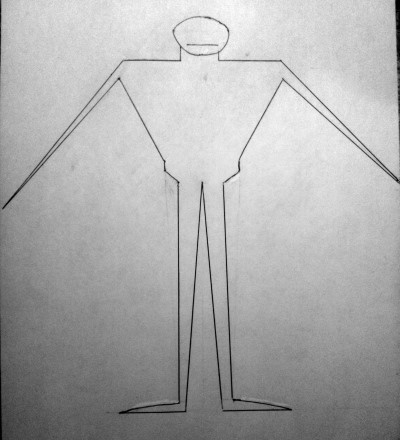
Illustration 6. Typical Subconscious Body image of the person with Psychopathic character structure.
Hysterical character structure.
Age at which this character structure is formed: 3–6 years.
Subconscious Body image. Clear gender identity. Long legs with small feet (indicating that the person avoids reality; ambitions) and long arms (the person is distant). A distinctly visible pelvis (a sign of sexuality), with a slim waist (representing the splitting of geniality and genitality). The chest may be broader than the shoulders (exaltation). A long and slim neck and a small head (indicating impulsiveness).
Actual body. Well groomed, flexible, agile, energetic and expressive. Clearly defined masculinity/femininity. Carefully dressed and accessorized, tattoos, etc.
Reason for the formation of such a body image. A fixation on sexuality and the Oedipal complex.
Psychological portrait. Seductive sexualized behaviour, although the person may not even be aware of this. Seduces the opposite sex and sees relations with members of the same sex as a competition. Negates sexuality in the name of geniality or rejects geniality in the name of sexuality. Defence mechanisms: seduction and denial. This type of person tends to go for professions where they will be the centre of attention (show business, television, public speaking) or which are connected with cosmetic beauty (designer, stylist).
Psychological help. Developing a healthy appreciation of sexuality. Forming an adequate sense of the person’s self-worth as a woman/man and helping them recognize the value of others. Integrating geniality and sexuality.
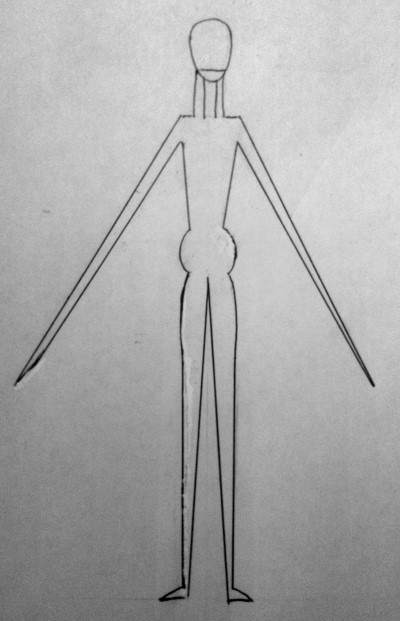
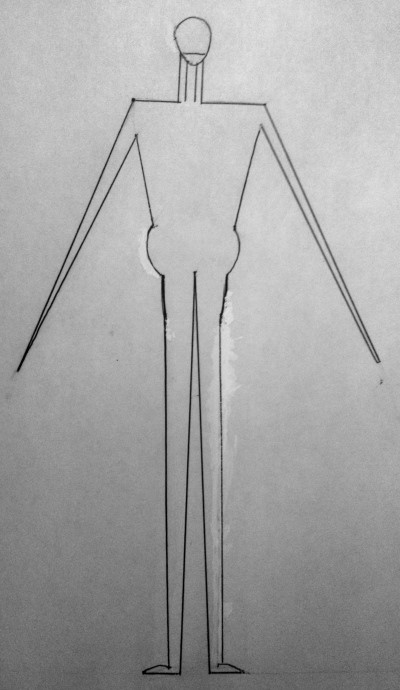
Illustration 7. Typical Subconscious Body Illustration 8. Typical Subconscious Body
image of a woman with Hysterical image of a man with Hysterical
character structure character structure.
In conclusion, I would like to say that body image can be corrected. Even a substantially distorted subconscious body image can be brought closer to reality. And the way to do this is to establish contact with yourself and with your body, including through methods of body-oriented psychotherapy.

